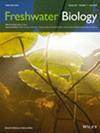临时生境中黄斑轮虫的有性繁殖:跨代和种群密度效应的检验
IF 2.7
2区 生物学
Q2 ECOLOGY
引用次数: 0
摘要
本研究探讨了可能影响奇瓦瓦沙漠水周期约为2-3周的Asplanchna brigh12lii轮虫种群性行为时间和倾向的内源性和环境因素。从沉积物中的休眠卵孵出的雌性茎开始,并在隐单胞菌(Cryptomonas erosa)上培养,这是一种含有生育酚(维生素E)的藻类,用于诱导单核细胞雌性,从而产生雄性和受精的休眠卵。关于白桦属植物有性生殖的承诺,考虑了两种假设。首先,在雄性雌性孵化后的早期和晚期孤雌生殖世代中,它的性倾向是否有所不同?第二,它的性倾向是否受到人口密度的影响?从茎雌连续10代对8个无性系进行的试验表明,世代对单雌生产倾向没有显著影响。在每代幼雌发起的小种群中,mictic雌的百分比一般较低(大平均值为9%)。对5个无性系的试验表明,单株繁殖倾向与密度无关。从出生开始,在70 mL或2 mL培养基中培养的单株无亲合力雌性产生的无亲合力子代的百分比没有显著差异,通常较低(0%-18%)。在实验室种群中,这些a . brightwellii无性系持续而低的有性繁殖倾向表明,只要饮食中含有生育酚并允许诱导单核细胞雌性,就会有低的、固定的性倾向。这种生命周期策略似乎适合于短暂的栖息地,在那里,水期和生长季节的持续时间非常短且不可预测。它保证在种群发育后不久产生一些休眠卵,而不会大大限制通过雌性孤雌生殖实现种群快速增长的潜力。有性倾向相对较高的克隆在较短的生长季节可能具有优势,反之亦然。本文章由计算机程序翻译,如有差异,请以英文原文为准。

Sexual Reproduction in the Rotifer Asplanchna brightwellii from a Temporary Habitat: Tests for Transgenerational and Population-Density Effects
- This study examines endogenous and environmental factors that might affect the timing and propensity for sex in a population of the rotifer Asplanchna brightwellii living in a Chihuahuan Desert habitat with hydroperiods of about 2–3 weeks. Multiple clones were initiated from stem females hatched from resting eggs in the sediment and cultured on Cryptomonas erosa, an alga containing tocopherol (vitamin E) required for induction of mictic females and hence production of males and fertilised resting eggs. Two hypotheses regarding the commitment of A. brightwellii to sexual reproduction were considered. First, does its propensity for sex differ in early and late parthenogenetic generations after stem females hatch? Second, is its propensity for sex affected by its population density?
- Experiments testing eight clones over 10 successive generations from the stem female showed no significant effect of generation on propensity for mictic-female production. Percentages of mictic females in small populations initiated by juvenile females from each generation generally were low (grand mean of 9%).
- Experiments with five clones showed that the propensity for mictic-female production was density independent. Percentages of mictic daughters produced by single amictic females cultured from birth in 70 mL or 2 mL did not differ significantly and generally were low (0%–18%).
- The persistent and low propensity for sexual reproduction in laboratory populations of these A. brightwellii clones suggests a low, fixed propensity for sex whenever the diet contains tocopherol and allows induction of mictic females. Such a life cycle strategy appears suitable for an ephemeral habitat, where the duration of hydroperiods and growing seasons is very short and unpredictable. It assures the production of some resting eggs soon after population development without greatly limiting the potential for rapid population growth via female parthenogenesis. Clones with a relatively high propensity for sex may have an advantage during shorter growing seasons, and vice versa.
求助全文
通过发布文献求助,成功后即可免费获取论文全文。
去求助
来源期刊

Freshwater Biology
生物-海洋与淡水生物学
CiteScore
5.90
自引率
3.70%
发文量
162
审稿时长
2 months
期刊介绍:
Freshwater Biology publishes papers on all aspects of the ecology of inland waters, including rivers and lakes, ground waters, flood plains and other freshwater wetlands. We include studies of micro-organisms, algae, macrophytes, invertebrates, fish and other vertebrates, as well as those concerning whole systems and related physical and chemical aspects of the environment, provided that they have clear biological relevance.
Studies may focus at any level in the ecological hierarchy from physiological ecology and animal behaviour, through population dynamics and evolutionary genetics, to community interactions, biogeography and ecosystem functioning. They may also be at any scale: from microhabitat to landscape, and continental to global. Preference is given to research, whether meta-analytical, experimental, theoretical or descriptive, highlighting causal (ecological) mechanisms from which clearly stated hypotheses are derived. Manuscripts with an experimental or conceptual flavour are particularly welcome, as are those or which integrate laboratory and field work, and studies from less well researched areas of the world. Priority is given to submissions that are likely to interest a wide range of readers.
We encourage submission of papers well grounded in ecological theory that deal with issues related to the conservation and management of inland waters. Papers interpreting fundamental research in a way that makes clear its applied, strategic or socio-economic relevance are also welcome.
Review articles (FRESHWATER BIOLOGY REVIEWS) and discussion papers (OPINION) are also invited: these enable authors to publish high-quality material outside the constraints of standard research papers.
 求助内容:
求助内容: 应助结果提醒方式:
应助结果提醒方式:


